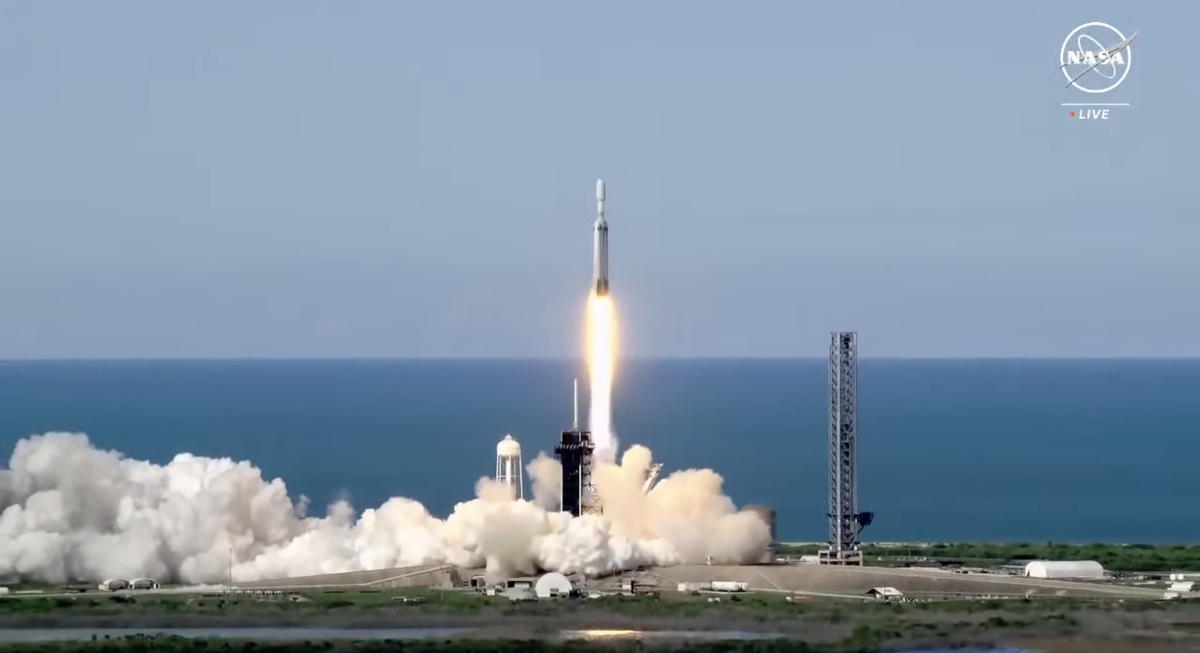WASHINGTON — A SpaceX Falcon Heavy rocket lifted off June 25 carrying the final spacecraft in a series of geostationary weather satellites that also features several firsts.
The Falcon Heavy lifted off from Kennedy Space Center’s Launch Complex 39A at 5:26 p.m. Eastern, 10 minutes into a two-hour window as launch directors found favorable weather despite forecasts the day before that predicted only a 30% chance of acceptable weather.
The rocket’s payload, the GOES-U weather satellite, is scheduled to deploy from the Falcon Heavy’s second stage four and a half hours after liftoff, once the stage completes a sequence of three burns to place the satellite into a geostationary transfer orbit.
GOES-U is the fourth and final satellite in the Geostationary Operational Environmental Satellite (GOES) R series of satellites built by Lockheed Martin for the National Oceanic and Atmospheric Administration. The spacecraft, which will be renamed GOES-19 once in geostationary orbit, will undergo on-orbit commissioning and then be moved to 75 degrees east in GEO and take over from GOES-16 as the operational GOES-East satellite.
The satellite carries a suite of earth and space science instruments similar to the three previous GOES-R satellites but also includes the Compact Coronagraph (CCOR) instrument for observing the sun. CCOR will monitor the solar corona for flares and coronal mass ejections that affect space weather, taking over for the nearly 30-year-old Solar and Heliospheric Observatory spacecraft.
Meteorologists say the observations provided by the first three GOES-R weather satellites have significantly improved weather forecasting. “The GOES-R series of satellites, it’s been a gamechanger for us,” Ken Graham, director of the National Weather Service, said at a June 24 pre-launch briefing. “Since the first launch of the series in 2016, the latest series of GOES has enabled new and improved forecasts, warnings and services to help save lives and protect property.”
Among the new capabilities in the GOES-R series is a lightning mapper. “For forecasters, I think it took them a while to realize what it could do,” said Pam Sullivan, director of the GOES-R program at NOAA, at another June 24 briefing. She said the lightning data allows meteorologists to better understand the severity of a storm and issue warnings accordingly. “The main thing I hear from forecasters is that they have more confidence in a forecast.”
NOAA is working on a new generation of geostationary weather satellites, called GeoXO and scheduled to start launching in 2032. NASA, which supports NOAA on the development of weather satellites, has awarded contracts to Lockheed Martin to build the satellites and to BAE Systems (formerly Ball Aerospace) to build sounder and ocean color instruments for the spacecraft.
GOES-U “is the bridge that connects today’s geostationary satellite technology with the technology of tomorrow that promises to be even more sophisticated and more impactful,” said Steve Volz, assistant administrator of NOAA’s Satellite and Information Service, of GeoXO.
The launch also marked the first time that NOAA launched a GOES weather satellite on a SpaceX rocket. The three previous GOES-R satellites all launched on Atlas 5 rockets from United Launch Alliance, but NASA awarded SpaceX a $152.5 million contract for a Falcon Heavy launch of GOES-U in September 2021. ULA withdrew its bid because it had no remaining Atlas rockets available.
One advantage of using the Falcon Heavy is the additional performance it provides. Julianna Scheiman, director of NASA science missions at SpaceX, said at a June 24 prelaunch briefing that the additional performance is measured in the form of the delta V, or change in velocity, the spacecraft itself needs to provide to reach its final geostationary orbit.
The mission requirements were for delta V of no higher than 987 meters per second, while Falcon Heavy will place GOES-U into a transfer orbit with a delta V of 566 meters per second. “A smaller number means less energy is required for the spacecraft to get to that orbit, which enables them to save that propellant,” she said.
Those propellant savings translate into a longer operational life for GOES-U. The spacecraft has a design specification of 15 years, said NOAA’s Sullivan. “With the added capability Falcon Heavy is giving us, we expect to be at 20-plus years of fuel life.”
The launch was the 10th for the Falcon Heavy overall and the second contracted by NASA, after the Psyche asteroid mission that launched in October 2023. Another Falcon Heavy will launch the Europa Clipper mission for NASA this October.
Related

Dr. Sarah Adams is a scientist and science communicator who makes complex topics accessible to all. Her articles explore breakthroughs in various scientific disciplines, from space exploration to cutting-edge research.






